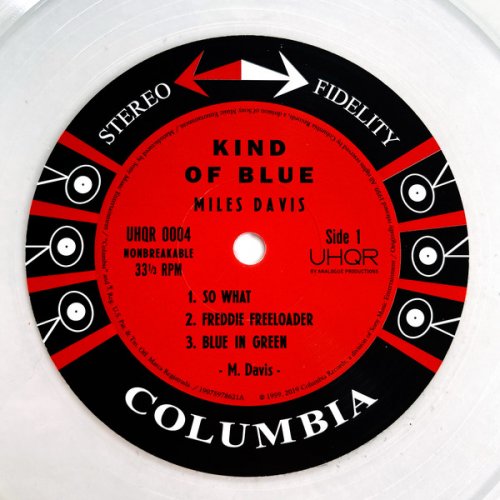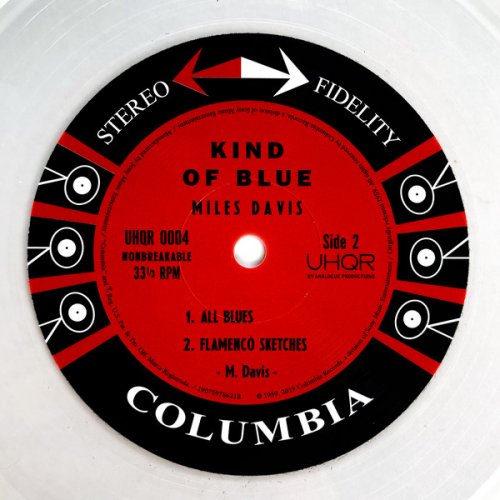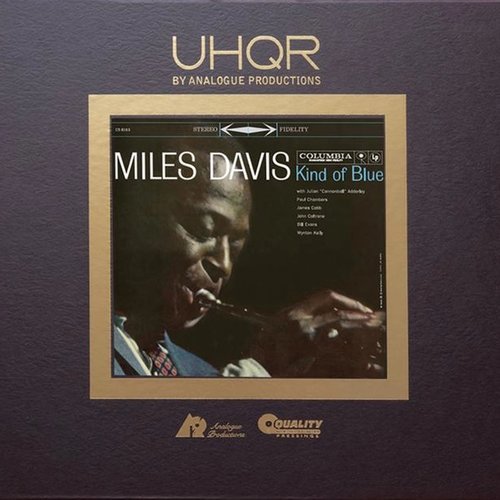
Miles Davis - Kind of Blue (2021, Reissue) LP
BAND/ARTIST: Miles Davis
- Title: Kind of Blue
- Year Of Release: 1959/2021
- Label: Analogue Productions (UHQR 0004)
- Genre: Hard Bop, Modal Music
- Quality: FLAC (tracks) 24/96
- Total Time: 00:45:34
- Total Size: 987 MB
- WebSite: Album Preview
Tracklist:
01. So What (Davis-G.Evans) - 9:11
02. Freddie Freeloader (Davis) - 9:49
03. Blue in Green (Davis-B.Evans) - 5:33
04. All Blues (Davis) - 11:38
05. Flamenco Sketches (Davis-B.Evans) - 9:23


01. So What (Davis-G.Evans) - 9:11
02. Freddie Freeloader (Davis) - 9:49
03. Blue in Green (Davis-B.Evans) - 5:33
04. All Blues (Davis) - 11:38
05. Flamenco Sketches (Davis-B.Evans) - 9:23
Is it possible to now write anything that hasn’t already been written or said about this record? I haven’t any fresh insights to offer that might advance what you probably already know. A good Kind of Blue pressing puts you in the 30th Street studio to hear the performance. Ashley Kahn’s “Kind of Blue” book sets the pre-recording stage, offering both musical and technical details and puts you as much in the control room as in front of the band.
According to Kahn, engineer Fred Plaut “…favored the new Telefunken U-49 microphones, a workhorse of the recording industry. Their warm, rounded response especially in the mid to lower range of the dynamic spectrum made them a favorite for jazz and other acoustic music sessions.” (I think Kahn meant of the frequency not the dynamic spectrum).
Each instrument was single-mic’d, except for Jimmy Cobb’s drum kit, which got two (one aimed at the snare, the other at the cymbals), for a total of 7.
In addition to the 30th Street studio’s natural reverberation, a low ceilinged concrete basement room about 12 feet by 15 feet fitted with a loudspeaker and omnidirectional microphone served as a reverb chamber. The session sound played through the speaker and picked up by the microphone was fed to the center channel, which was also bassist Paul Chambers’ placement in the mix. That might explain the odd bass decay after one of Chambers’ plucks at the beginning of “So What”. Of course, even without the reverb chamber, there’s major microphone leakage, which produces this recording’s remarkable three-dimensionality as well as image solidity.
Do you also know that record presses sound different much as do cutting systems, cartridges, turntables, phono preamps and everything else in the analog recording, cutting and playback chain?
SMT, Lened, Toolex Alpha, Finebilt hand presses and others have not too difficult to discern sonic characteristics. So I have to laugh when I read comments like “if you have a Classic Records pressing of Kind of Blue “you are all set”.
Trust me, you are not “all set”, unless to you this record is of minor importance or you don’t care to own what is clearly and easily the best sounding Kind of Blue.
I compared this Finebilt, UHQR “flat profile” pressing sourced from metal parts made from Bernie Grundman’s 1997 lacquer cut (this record features the speed corrected version of side 1), produced from the original 3 track tape mixed “live” to two tracks to: two original Columbia “6-Eye” pressings, to Classic’s 33 !/3 double LP 180 gram side one speed corrected set, to the 45rpm single sided set and to Mobile Fidelity’s double 45rpm set sourced not from a “live 3:2 mix” but from Mark Wilder’s 3:2 tape dub.
Why mince words or meat for the that matter, a “live 3:2 mix” cut directly from the 3 track master has to sound more immediate and transparent than one cut from at least a generation down 2 track mixdown tape and even though the Mo-Fi was cut at 45rpm, the UHQR is far more transparent. Just compare Wynton Kelly’s piano solo on “Freddie Freeloader”. The Classic Records reissue was the first and only time the lacquers were cut “live” using the 3-Track master tape—and that includes the original pressing, which also was cut from a mixdown tape.
The “flat profile” record is not a gimmick. If you’ve seen the cross section of a standard LP, the stylus goes slightly “downhill” over the first half of the record and then “uphill” to the end. The flat profile eliminates the valley”. That matters. Not in a profound way, but consider that this is all happening in a microscopic miniature world where every variation from ideal produces some negative and often sonic effect.
The original pressing is of course the “document of record” (pun intended). It has a romantic transient blur to it that’s ear-pleasing but clearly not what’s on the tape. Add the era’s relatively noisy vinyl (even when it’s “quiet” as you’ll hear, compared to the Clarity vinyl, which is really quiet).
The two Classic Records reissues sound closest to the new UHQR and to suggest that the UHQR is a “must have” if you have either of those or the Quiex 200g version would be hyperbolic so I’m not going to suggest that, but were you to buy the UHQR and your turntable is sufficiently resolving, precise and quiet, the difference between the Classic and QRP UHQR is significant, almost like putting on 3D glasses or focusing an out of focus pair of binoculars—never mind the focus difference between the UHQR and the original pressing.
Part of this is no doubt the vinyl formulation but more of it I think is the Finebilt handpress, which has a longer press time and which has had the chassis shaking hydraulics removed and placed on its own isolated platform. Especially if this record is seared into your brain from decades of exposure, you’ll immediately hear the improved focus, which does not come at the expense of the recording’s famous lush, rich and full warm instrumental sound and it’s upper frequency transient precision and clarity in front of the somewhat wet space.
Add to that the deluxe UHQR box, the Stoughton laminated “tip-on” gatefold jacket and a nicely presented nearly full sized booklet that includes session photographs you won’t want to not look at and the original 1997 Robert Palmer (the music critic and one time “Insect Trust” band member) essay as well as a new one from Ashley Kahn. Enough said!
That’s the end of the review. Now here’s the capsulized “audiophile press” review:
"Quite clearly and obviously this new UHQR Kind of Blue sourced from Bernie Grundman’s 1995 “live” mix from the 3 track master, directly to lacquer sounds best compared to two early “6-Eyes”, Classic’s own double 180g set and that label's single-sided 45rpm set, and Mobile Fidelity’s double 45 boxed edition, to which I compared the UHQR.
“Even the quietest original pressing creates a pleasing romantic blur over a soft bed of noise but compared to this issue the overall picture is distant and hazy (though the romanticized version still pulls). The UHQR offers the blackest, quietest backgrounds and unparalleled transparency, but more critically, the modified Finebuilt hand press produces unprecedented transient precision and instrumental focus and resolves low level details that will deliver surprises to even the most blasé KOB veteran, one of whom visited and exclaimed “I’ve never heard that before”. This pressing allows you to see further into the mix and transports you back in time and into the 30th Street studios. I don’t care what version you now have you’ve never heard Kind of Blue quite like this. And that’s not hyperbole!" OK it is hyperbole but hey! The thing is and add your own tired cliché here.
According to Kahn, engineer Fred Plaut “…favored the new Telefunken U-49 microphones, a workhorse of the recording industry. Their warm, rounded response especially in the mid to lower range of the dynamic spectrum made them a favorite for jazz and other acoustic music sessions.” (I think Kahn meant of the frequency not the dynamic spectrum).
Each instrument was single-mic’d, except for Jimmy Cobb’s drum kit, which got two (one aimed at the snare, the other at the cymbals), for a total of 7.
In addition to the 30th Street studio’s natural reverberation, a low ceilinged concrete basement room about 12 feet by 15 feet fitted with a loudspeaker and omnidirectional microphone served as a reverb chamber. The session sound played through the speaker and picked up by the microphone was fed to the center channel, which was also bassist Paul Chambers’ placement in the mix. That might explain the odd bass decay after one of Chambers’ plucks at the beginning of “So What”. Of course, even without the reverb chamber, there’s major microphone leakage, which produces this recording’s remarkable three-dimensionality as well as image solidity.
Do you also know that record presses sound different much as do cutting systems, cartridges, turntables, phono preamps and everything else in the analog recording, cutting and playback chain?
SMT, Lened, Toolex Alpha, Finebilt hand presses and others have not too difficult to discern sonic characteristics. So I have to laugh when I read comments like “if you have a Classic Records pressing of Kind of Blue “you are all set”.
Trust me, you are not “all set”, unless to you this record is of minor importance or you don’t care to own what is clearly and easily the best sounding Kind of Blue.
I compared this Finebilt, UHQR “flat profile” pressing sourced from metal parts made from Bernie Grundman’s 1997 lacquer cut (this record features the speed corrected version of side 1), produced from the original 3 track tape mixed “live” to two tracks to: two original Columbia “6-Eye” pressings, to Classic’s 33 !/3 double LP 180 gram side one speed corrected set, to the 45rpm single sided set and to Mobile Fidelity’s double 45rpm set sourced not from a “live 3:2 mix” but from Mark Wilder’s 3:2 tape dub.
Why mince words or meat for the that matter, a “live 3:2 mix” cut directly from the 3 track master has to sound more immediate and transparent than one cut from at least a generation down 2 track mixdown tape and even though the Mo-Fi was cut at 45rpm, the UHQR is far more transparent. Just compare Wynton Kelly’s piano solo on “Freddie Freeloader”. The Classic Records reissue was the first and only time the lacquers were cut “live” using the 3-Track master tape—and that includes the original pressing, which also was cut from a mixdown tape.
The “flat profile” record is not a gimmick. If you’ve seen the cross section of a standard LP, the stylus goes slightly “downhill” over the first half of the record and then “uphill” to the end. The flat profile eliminates the valley”. That matters. Not in a profound way, but consider that this is all happening in a microscopic miniature world where every variation from ideal produces some negative and often sonic effect.
The original pressing is of course the “document of record” (pun intended). It has a romantic transient blur to it that’s ear-pleasing but clearly not what’s on the tape. Add the era’s relatively noisy vinyl (even when it’s “quiet” as you’ll hear, compared to the Clarity vinyl, which is really quiet).
The two Classic Records reissues sound closest to the new UHQR and to suggest that the UHQR is a “must have” if you have either of those or the Quiex 200g version would be hyperbolic so I’m not going to suggest that, but were you to buy the UHQR and your turntable is sufficiently resolving, precise and quiet, the difference between the Classic and QRP UHQR is significant, almost like putting on 3D glasses or focusing an out of focus pair of binoculars—never mind the focus difference between the UHQR and the original pressing.
Part of this is no doubt the vinyl formulation but more of it I think is the Finebilt handpress, which has a longer press time and which has had the chassis shaking hydraulics removed and placed on its own isolated platform. Especially if this record is seared into your brain from decades of exposure, you’ll immediately hear the improved focus, which does not come at the expense of the recording’s famous lush, rich and full warm instrumental sound and it’s upper frequency transient precision and clarity in front of the somewhat wet space.
Add to that the deluxe UHQR box, the Stoughton laminated “tip-on” gatefold jacket and a nicely presented nearly full sized booklet that includes session photographs you won’t want to not look at and the original 1997 Robert Palmer (the music critic and one time “Insect Trust” band member) essay as well as a new one from Ashley Kahn. Enough said!
That’s the end of the review. Now here’s the capsulized “audiophile press” review:
"Quite clearly and obviously this new UHQR Kind of Blue sourced from Bernie Grundman’s 1995 “live” mix from the 3 track master, directly to lacquer sounds best compared to two early “6-Eyes”, Classic’s own double 180g set and that label's single-sided 45rpm set, and Mobile Fidelity’s double 45 boxed edition, to which I compared the UHQR.
“Even the quietest original pressing creates a pleasing romantic blur over a soft bed of noise but compared to this issue the overall picture is distant and hazy (though the romanticized version still pulls). The UHQR offers the blackest, quietest backgrounds and unparalleled transparency, but more critically, the modified Finebuilt hand press produces unprecedented transient precision and instrumental focus and resolves low level details that will deliver surprises to even the most blasé KOB veteran, one of whom visited and exclaimed “I’ve never heard that before”. This pressing allows you to see further into the mix and transports you back in time and into the 30th Street studios. I don’t care what version you now have you’ve never heard Kind of Blue quite like this. And that’s not hyperbole!" OK it is hyperbole but hey! The thing is and add your own tired cliché here.


Year 2021 | Jazz | FLAC / APE | HD & Vinyl
As a ISRA.CLOUD's PREMIUM member you will have the following benefits:
- Unlimited high speed downloads
- Download directly without waiting time
- Unlimited parallel downloads
- Support for download accelerators
- No advertising
- Resume broken downloads


